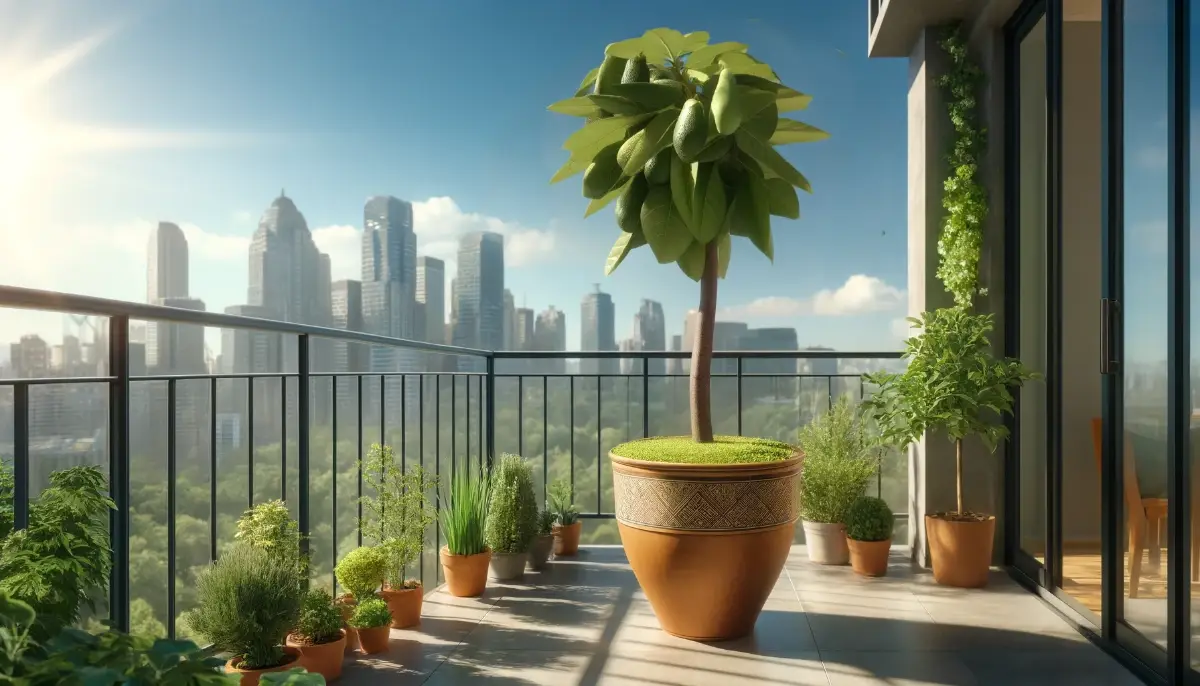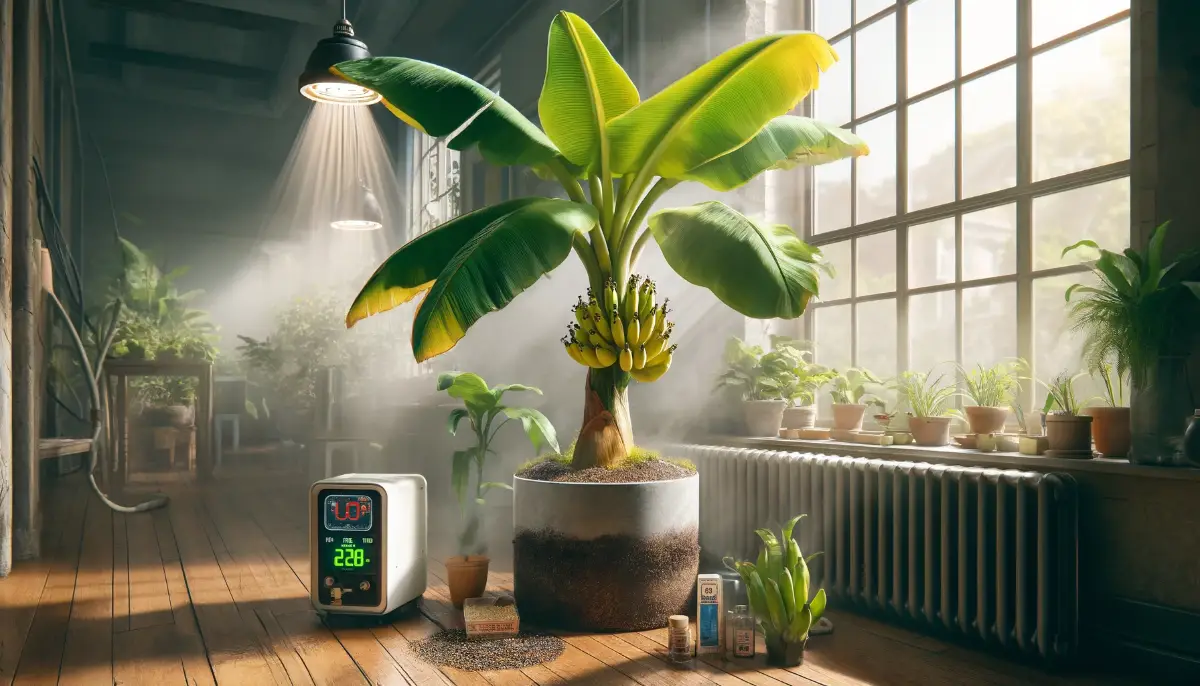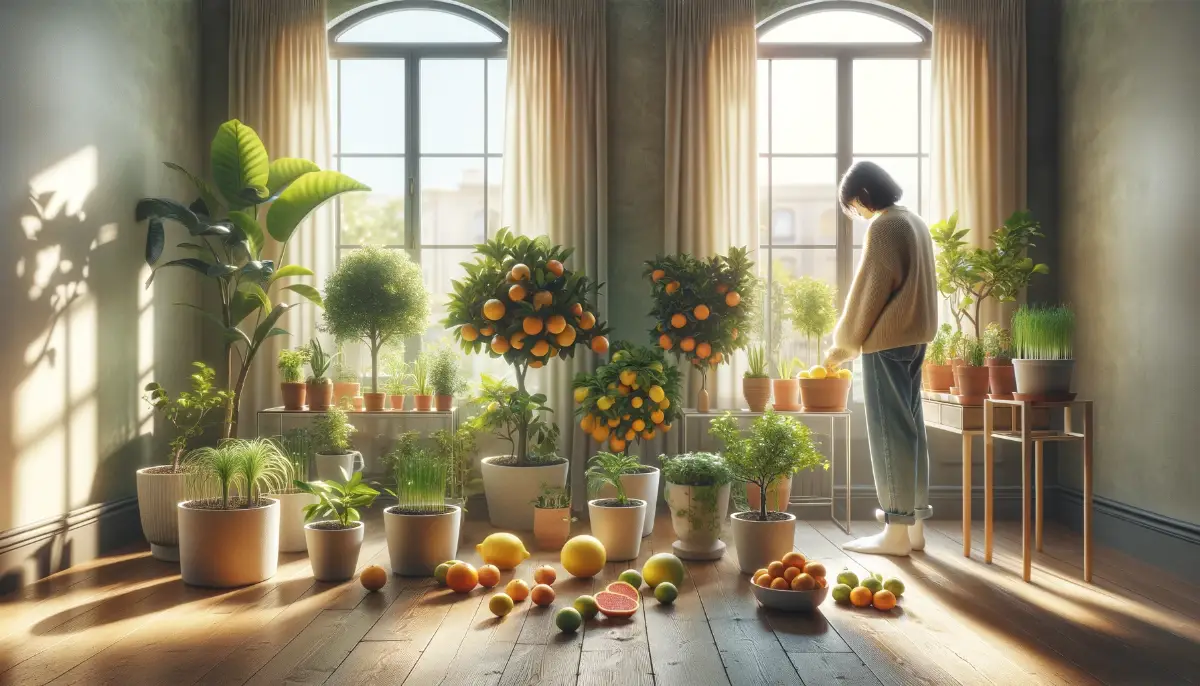Growing pineapples in containers offers a delightful blend of practical gardening and exotic tropical charm right in your own home.
This easy-to-follow endeavor not only adds a vibrant, leafy aesthetic to your living spaces but also brings a taste of the tropics to your table.
Ideal for those with limited garden space, container gardening allows you to control the environment of your pineapple plant, ensuring it receives the right amount of sunlight, warmth, and water.
- Pineapples can be grown in containers both indoors and outdoors.
- They require minimal care once established, thriving in warm, sunny conditions.
- The planting process involves rooting the pineapple top in soil or water.
Choosing and Preparing the Pineapple Top
Selecting the Pineapple: Look for a fresh pineapple with healthy, green leaves, not yellow or brown. The fruit itself should be plump and firm with a golden-brown skin. A good sign of ripeness and health is if one of the top leaves can be easily pulled out with a gentle tug.
Preparing the Top: Start by cutting off the top of the pineapple. You’ll want to include about an inch of the fruit’s flesh. After cutting, carefully strip away some of the lower leaves to expose the stem, which will help in rooting.
Drying the Crown: Allow the pineapple top to dry for a day or two. This step is crucial as it helps prevent rot when you plant the crown. Drying forms a callous over the cut areas, reducing the risk of infection.
Planting: Once the top is prepared and dried, it’s ready to be planted into your container. Make sure to use well-draining soil to encourage healthy growth and prevent root rot.
Selecting the Right Container
Selecting the right container is a pivotal step in successfully growing pineapples indoors. Here’s what to consider to ensure your pineapple thrives:
Size: Pineapples need space to grow, so choose a container that is at least 5 gallons in volume. This size allows enough room for the roots to expand without being overly constrained.
Material: Containers made from materials like plastic, clay, or ceramic are all suitable for growing pineapples. Each material has its pros and cons: plastic is lightweight and inexpensive, clay provides good moisture and air flow but is heavier, and ceramic pots can be decorative but may require more frequent watering due to their porous nature.
Drainage: Good drainage is essential to prevent water from pooling at the bottom of the container, which can lead to root rot. Ensure the container has one or more drainage holes at the bottom. If your selected pot doesn’t have holes, you can drill some yourself or choose another pot that does.
Depth and Width: Since pineapple plants have a relatively shallow root system but can grow quite wide, the container should be wider than it is deep. A broad, shallow pot is ideal, providing space for the plant to stabilize and spread.
Choosing the appropriate container not only supports the healthy growth of your pineapple plant but also integrates it into your home decor, making it both a functional and attractive addition to your living space.
For successful growth of pineapples in containers, both the soil and planting method play crucial roles. Here are the essential requirements:
Soil and Planting Requirements
Soil Composition: Pineapples require light, well-draining soil that allows air to circulate around the roots. A mixture containing equal parts of loamy soil, sand, and a bit of organic matter such as compost is ideal. This ensures good drainage and prevents waterlogging, which is detrimental to the plant’s health.
pH Level: The soil should be slightly acidic, with a pH between 4.5 and 6.0. This pH level supports the optimal uptake of nutrients by the pineapple plant.
Planting the Crown: When planting the pineapple top, ensure that the soil is firm around the base to hold it upright. Plant the crown so that the base is just buried, leaving the leafy top exposed. This encourages the roots to develop and anchor the plant firmly.
Use of Permeable Materials: To enhance drainage, consider adding perlite or small pebbles at the bottom of the container before adding soil. This extra layer helps manage moisture levels within the pot, reducing the risk of root rot.
By following these soil and planting guidelines, you can create an optimal environment for your pineapple to thrive in a container setting. Ensuring the right soil composition and proper planting technique will set your pineapple on the path to healthy growth and eventual fruiting.
Light and Temperature Needs
Pineapples are tropical plants that thrive in warm, sunny environments, making their light and temperature requirements critical for successful growth, especially when grown in containers:
Sunlight Requirements: Pineapples require a lot of light to flourish. They should receive at least 6-8 hours of direct sunlight each day. If you are growing pineapples indoors, place them near a south-facing window to ensure they receive ample light. If natural light is insufficient, consider using grow lights to supplement.
Temperature Needs: Pineapples prefer warm temperatures ranging from 65°F to 85°F (18°C to 29°C). They can tolerate a minimum temperature of about 60°F (15°C), below which their growth can slow down significantly. It’s important to keep them in a warm environment, especially during the cooler months. If temperatures in your area drop below this range, you should move the container indoors or to a warmer spot.
Protection from Extreme Temperatures: While pineapples like warm weather, they can get stressed in temperatures exceeding 90°F (32°C). In such conditions, providing some shade during the hottest part of the day can help prevent overheating. Likewise, in cooler climates, protection from cold snaps is essential, as freezing temperatures can damage the plant.
Maintaining the right light exposure and temperature for your pineapple plant is crucial for its health and fruit production. Ensuring these conditions will help your pineapple thrive, whether it’s grown indoors or outside in a container.
Watering and Feeding
Pineapples like consistent moisture but are susceptible to overwatering, which can lead to root rot. Here are some guidelines for watering:
- Watering Frequency: Water your pineapple plant when the top 1-2 inches of soil feel dry to the touch. This might typically be about 2-3 times per week, depending on the temperature and humidity of your environment.
- Method of Watering: It’s advisable to water the plant from the top to mimic natural rainfall, which helps in distributing nutrients throughout the plant. Ensure that the soil is thoroughly soaked each time you water, allowing excess water to drain out of the container.
Organic Feeding
Feeding your pineapple plant with the right nutrients can significantly boost its growth and fruit production:
- Fertilizer Selection: Use a balanced, organic fertilizer that includes nitrogen, phosphorus, and potassium. Products like fish emulsion or seaweed extract are excellent organic options that support healthy growth without the risk of chemical buildup in the soil.
- Application Schedule: Apply fertilizer once every month during the growing season. During the cooler months or when the plant is less active, you can reduce the frequency to once every other month. Always follow the manufacturer’s instructions on the packaging for the best results.
By monitoring the watering needs based on the plant’s environment and feeding it appropriately, you can help ensure your pineapple thrives and eventually produces that sweet, tropical fruit right from your home.
Common Pests and Diseases
When growing pineapples in containers, it’s important to be aware of potential pests and diseases that could affect your plant. Here are some common issues and how to manage them:
Common Pests
- Mealybugs: These pests feed on the sap of the leaves, which can weaken the plant. They appear as small, white, fluffy spots on leaves and stems. Combat them by washing the plant with a strong spray of water or applying insecticidal soap. Best Organic Methods to Control Mealybug Infestations
- Scale Insects: Similar to mealybugs, scale insects also suck sap from the leaves, leaving behind sticky residue and causing yellowing of leaves. They can be treated with neem oil or horticultural oil applied according to product instructions.
Common Diseases
- Root Rot: Overwatering can lead to fungal diseases like root rot, where the roots of the plant decay due to excess moisture. Ensure good drainage in the container and allow the soil to dry between waterings to prevent this condition.
- Bacterial Heart Rot: This disease manifests as water-soaked lesions on the white basal sections of the leaves, turning the mid-portions olive green. Affected plants should be removed and destroyed to prevent spread. Avoid injury to the plant as the bacteria can enter through wounds.
- Black Rot: Caused by a fungus, this disease begins with small wet spots on the leaves, which enlarge and turn grey-brown. It can also affect the fruit, causing internal rot before external signs are visible. Preventive measures include ensuring good air circulation around the plant and avoiding overhead watering.
Managing these pests and diseases effectively involves regular monitoring of your plant, proper watering practices, and using appropriate organic pesticides when necessary. Keeping your pineapple plant healthy through preventive care is key to avoiding these common issues and ensuring a successful harvest.
Harvesting Your Pineapple
Harvesting your pineapple is an exciting culmination of your gardening efforts. Here are the steps and signs to look for to know when your pineapple is ready to harvest:
Maturity Indicators: It typically takes about 18-24 months for a pineapple plant to produce its first fruit. The fruit is ready to harvest when the skin turns a golden color and you can smell a sweet, strong pineapple aroma near the base. The leaves at the top may also begin to dry out .
Visual Cues: As the pineapple matures, its color changes from green to yellow, starting at the base and moving upward. Wait until the color change has progressed at least halfway up the fruit.
Harvesting Technique: Use a sharp knife or garden shears to cut the pineapple from the plant. Cut the stalk close to the base of the fruit to avoid damaging the plant, which may continue to produce more fruits if younger suckers are present.
Post-Harvest: Once harvested, allow the pineapple to ripen at room temperature if it isn’t fully yellow. Pineapples do not continue to ripen significantly after being harvested, so it’s best to use them within a few days once they reach their peak ripeness.
FAQs about growing pineapples
How long does it take for a pineapple to mature in a container?
It typically takes between 18 to 24 months for a pineapple plant to mature and produce fruit when grown in a container.
Can I grow a pineapple plant indoors?
Yes, pineapples can be grown indoors. They need a sunny spot with at least 6-8 hours of direct sunlight daily, or supplemental light from grow lights.
What is the best soil mix for growing pineapples in containers?
A light, well-draining soil mix with components like loamy soil, sand, and a bit of organic matter is ideal for pineapples.
How often should I water my pineapple plant?
Water your pineapple plant when the top 1-2 inches of soil are dry to the touch. Generally, this will be about 2-3 times per week, depending on environmental conditions.
What are the common pests that affect pineapple plants?
Common pests include mealybugs and scale insects, which can be managed using insecticidal soap or neem oil.
How do I know when my pineapple is ready to harvest?
The pineapple is ready to harvest when its skin turns golden and it emits a strong, sweet fragrance. The change in color usually starts at the base and works its way up.
Do pineapple plants need a lot of sunlight?
Yes, pineapple plants require at least 6-8 hours of direct sunlight each day. If grown indoors, a south-facing window or a grow light may be necessary.
Can pineapples survive in cold weather?
Pineapples are tropical plants and cannot tolerate freezing temperatures. If you live in a cold climate, you must bring the plant indoors during winter to avoid frost damage.
What type of fertilizer is best for pineapples?
Use a balanced, organic fertilizer that includes nitrogen, phosphorus, and potassium. Fish emulsion or seaweed extract are good options.
How do I prevent root rot in my container-grown pineapple?
Ensure the container has good drainage and the soil does not retain excess water. Water the plant only when the top layer of soil feels dry to prevent overwatering.










